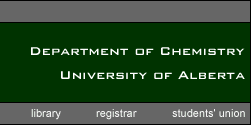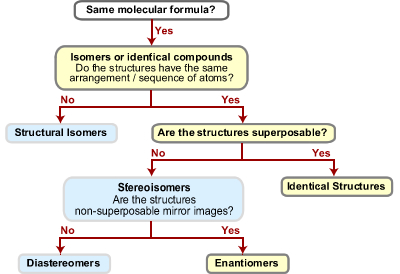


Chem 161 - Lecture Outline & Assignment #4
Readings:
TWG Solomons and CB Fryhle "Organic Chemistry" 8th Edition (2004):
- Functional Group List on pp 70-71 and Periodic Table (1 page back from Back Cover)
- Chapter 5 – Stereochemistry: Chiral Molecules
- Chapter 6 – Ionic Reactions: Nucleophilic Substitution and Elimination Reactions
- Chapter 7 – Alkenes and Alkynes I: Re-Read
Problems:
Do Not turn in, answers available in "Study Guide and Solutions Manual for Organic Chemistry" by Solomons and Fryhle.
Chapter 5:
5.1 to 5.5; 5.7 to 5.19; 5.23; 5.24; 5.30; 5.33; 5.35Chapter 6:
6.1 to 6.5; 6.7 to 6.9; 6.12 to 6.14; 6.30Chapter 7:
7.1; 7.3; 7.5 to 7.9; 7.13; 7.14; 7.26; 7.29; 7.34
Lecture Outline 4:
Stereochemistry & Nucleophilic Substitution and Elimination Reactions (SN1, SN2 and E1, E2)
- Comparison of 2 Structures

- Chirality and Stereoisomers
- The Concept of Chirality
- Identification of chiral objects and molecules – definitions
- achiral = not chiral
- planes of symmetry within a molecule
- Types of stereoisomers: enantiomers and diastereomers
- Identification of chiral objects and molecules – definitions
- Location of Stereogenic (Chiral) centers – 4 different groups on tetrahedral atom
- Enantiomers and Diastereomers
- Meso compounds - chiral centers with plane of symmetry within molecule
- Molecules with more than one chiral center
- Recognition of chiral centers in complex molecules: cholesterol – 8 chiral centers
- drawing the enantiomer of cholesterol
- relationship of cholesterol and its potential 255 stereoisomers
- Fisher Projections
- R and S Nomenclature
- Rules for assignment of R and S configurations
- Treatment of multiple bonds – example: 3-bromo-1-pentene
- The Concept of Chirality
- Optical Rotation, Optical Purity and Resolution of Enantiomers
- Optical Rotation
- Measurement, factors, and absolute rotation
- Optical purity and enantiomeric excess
- Physical Properties of Enantiomers and Diastereomers
- Racemic mixtures – 50:50 mixtures of enantiomers
- Optical Purity = enantiomeric excess
- Separation (Resolution) of Enantiomers (e.g. Racemic mixtures)
- Creation of diastereomers
- Biological recognition
- Optical Rotation
- Nucleophilic Substitution Reactions (SN1 and SN2)
- General features of Nucleophilic Substitution vs. Elimination reactions
- Definitions: SN1 and SN2
- Mechanisms
- SN2 Reactions
- Stereochemistry – Walden Inversion (inversion of configuration)
- Substitution of primary and secondary alkyl halides
- Synthesis of alcohols, ethers, other halides, etc.
- Replacement of acetylenic hydrogen
- Acidity of alkynes
- Alkylation – Substitution Reactions
- SN1 Reactions
- Stereochemical aspects (loss of stereochemistry via carbocations)
- Substitution of tertiary alkyl halides and other tertiary carbons
- Synthesis of alcohols, ethers, halides
- General features of Nucleophilic Substitution vs. Elimination reactions
- Elimination Reactions - E1 and E2 Competition with Substitution Reactions (SN1 and SN2)
- El Mechanism – Saytzeff (Zaitsev) Rule, Leaving Groups
- E2 Mechanism – Stereochemistry
- Competition of Elimination Reactions (E2 and E1 vs. SN1 and SN2)